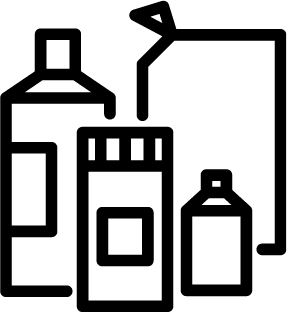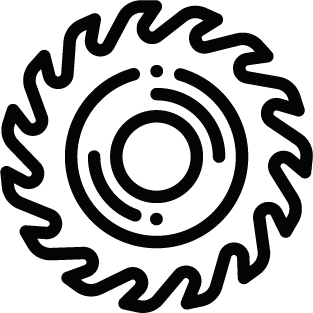FAQs — Cleaning
1. How often should I clean my patio?
The frequency of patio cleaning largely depends on the paving material that you have chosen, its usage, and the local environment. Generally, we recommend that you sweep your patio weekly to remove leaves and other debris. A more thorough washing or deep cleaning should ideally be done at least twice a year — once in the spring, to clear away any grime accumulated over the winter, and again in the autumn, to prepare it for the colder months.
If your patio is under heavy tree cover, or subject to frequent use, you might need to clean it more often to prevent moss, algae growth and stains. Regular maintenance not only keeps your patio looking its best, but also extends its lifespan by preventing damage and deterioration. Find out more about cleaning a natural stone patio and cleaning outdoor porcelain tiles.
2. Is porcelain zero-maintenance?
While porcelain paving slabs are extremely low-maintenance, it’s a myth that they are completely maintenance-free. Porcelain is highly resistant to stains, scratches and frost, and its minimal upkeep requirements make it an ideal choice for outdoor use.
However, to keep porcelain looking its best, routine cleaning is still needed. This usually involves sweeping off debris and occasional washing with water to remove dirt and minor stains. Like natural stone, porcelain can also be cleaned intensively with a power wash a couple of times per year. Also take extra care with the placement of light-coloured porcelain, which will show up darker marks from, for example, fallen leaves more easily, and avoid areas where there is heavy over-hanging vegetation.
3. What equipment do I need to clean my patio?
Cleaning your patio quickly and to a good standard requires a few essential tools and materials. Here’s what you’ll typically need:
Broom: A good, stiff broom is vital for sweeping away loose debris such as leaves, dirt, and dust. Alternatively, you can also use a leaf blower for this purpose.
Pressure washer: For deep cleaning, a pressure washer can remove tough grime, stains and moss that a broom won’t touch. It’s important to use a jet wash correctly. Use a medium pressure setting and under no circumstances use the fine spray as this can damage and etch the surface of the paving slabs.
Garden hose: if carrying out a light clean, a standard garden hose with a spray nozzle can be a gentler alternative to a pressure washer.
Scrub brush: For stubborn stains or areas where moss and algae have built up, a scrub brush is a useful tool in your patio-cleaning armoury.
Weed removal tool: If weeds are growing between the paving stones, which can happen with clay and brick pavers, a weed removal tool is useful
Rubber gloves: To protect your hands from harsh cleaners or when handling dirty water.
Safety goggles: These are important to protect your eyes from splashes, if using a pressure washer or harsh chemicals.
These tools will help you tackle most patio-cleaning tasks. Regular cleaning, not only enhances the appearance of your patio, but also helps to avoid damage, prolonging the patio’s lifespan.
4. Can I use a patio cleaner on my natural stone?
Yes, but the content of natural stone can sometimes react with certain types of chemical cleaner, so it’s always best to check with one of our sales advisors before you use a patio cleaner. You can find a guide to patio cleaner options on our blog.
Always test cleaners on a small area before full application and never use an acid-based cleaner on limestone or basalt paving – the acid will react with the stone and cause permanent damage.
5. What’s the best way to remove organic marks or general dirt and grime from my natural stone paving?
For general dirt or organic marks like grass stains, mud etc. we recommend Lithofin Outdoor Cleaner. Just dilute, apply and jet-wash off as per the instructions on the bottle.
When cleaning your stone, you will find that a jet-wash (possibly in conjunction with a chemical cleaning agent, like Lithofin Outdoor Cleaner) will give the best results. This is because dirt particles enter the pores of the stone, and the mechanical action of the jet-wash is needed to lift them out. Just don’t hold the jet-wash too close to the surface of the stone; otherwise, you may cause etch marks. 500-600mm away is perfect. Discover more on the best way to use a jet wash.
6. How can I remove cement or stubborn marks from my natural stone paving?
Cement is notoriously difficult to remove once it’s dry, since it becomes engrained in the pores of the stone. So, as spills happen during installation or pointing, it’s much better to clean them away immediately with clean water and a sponge.
For stubborn marks or cement-based stains, Lithofin Builders’ Clean is a good choice. It is acid-based, though, and so MUST NOT be used on limestone or basalt products. Discover more the best cleaners for stone paving, including Dry Treat Alkaline Cleaner, which can be used on limestone, and why acid-based cleaners should be used with care on all stone.
When cleaning your stone, you will find that a jet-wash (possibly in conjunction with a chemical cleaning agent, like Lithofin Builders’ Clean) will give the best results. This is because dirt particles enter the pores of the stone, and the mechanical action of the jet-wash is needed to lift them out. Just don’t hold the jet-wash too close to the surface of the stone; otherwise, you may cause etch marks. 500-600mm away is perfect. Discover more on the best way to use a jet wash.
7. How do I prevent algae growth on my patio?
Algae growth on patios can be unsightly and slippery, posing a safety risk. To prevent algae from taking hold, follow these practical tips:
Improve sunlight exposure: North-facing gardens are particularly susceptible to algae, which thrives in damp, shaded areas. If possible, cut overhanging branches to increase sunlight on your patio. This helps dry out the surface and prevents algae growth.
Ensure proper drainage: Sitting water promotes algae and moss growth. Ensure your patio slopes slightly away from your house or garden to facilitate proper drainage and prevent water pooling.
Clean regularly: Routinely sweep and wash your patio to remove dirt and organic matter that algae thrive on. A regular cleaning programme will significantly reduce the likelihood of algae establishing.
Seal the patio: Applying a sealant to your paving slabs prevents water being absorbed into the pores of the material and will reduce algae growth.
Check for leaks: Ensure there are no leaks from gutters or downpipes that could be contributing to excess moisture on your patio.
Find more information on preventing algal growth on your patio on our blog.
8. My stone is sealed but the surface is marked with footprints. I’ve hosed down the stone, but they won’t come off – why?
Sealing your stone will help to protect against permanent stains and will make cleaning much easier in comparison to unsealed stone. However, it will not stop marks from appearing or make the stone ‘self-cleaning’.
Dry Treat—the stone sealant we recommend—is an impregnator. This means it coats the particles of the stone to around 6mm beneath the surface and leaves the pores of the stone open. Lesser quality, topical sealants coat the entire surface of the slab like a varnish. This surface coat often causes an unsightly sheen and can wear away very quickly, especially in areas that get a lot of foot traffic. Discover more about the differences between topical and impregnating sealants on our blog.
Being an impregnator is what makes Dry Treat such a long-lasting and cost-effective solution. The fact that the pores remain open allows the stone to breathe, but it means that mud from animal prints or rubber from shoe soles can become engrained in the pores of the stone and will need to be jet-washed to lift the dirt particles out.
On pale and porous products, in particular, the first couple of marks on the stone will stand out, since the product is brand-new and completely clean. Rather than rushing to jet-wash the stone, we advise that you allow it to weather in a little bit. Over time, exposed to the elements, the marks will become less noticeable and the odd footprint or mark will not stand out. You can then begin a regular cleaning regime that involves jet-washing the stone, possibly in conjunction with a chemical cleaning agent, once or twice a year.

/filters:quality(40)/mediadev/media/homepage/price_right_arrow.svg)
/filters:quality(60)/mediadev/media/menu-pics/menu_banner_mobile.png )
/filters:quality(60)/mediadev/media/menu-pics/all-porcelain.jpg )
/filters:quality(60)/mediadev/media/menu-pics/premium-italian.jpg )
/filters:quality(60)/mediadev/media/menu-pics/budget-porcelain.jpg )
/filters:quality(60)/mediadev/media/menu-pics/large-format-porcelain.jpg )
/filters:quality(60)/mediadev/media/menu-pics/wood-effect-porcelain.jpg )
/filters:quality(60)/mediadev/media/menu-pics/porcelain-planks.jpg )
/filters:quality(60)/mediadev/media/menu-pics/porcelain-setts.jpg )
/filters:quality(60)/mediadev/media/menu-pics/browse-all-paving.jpg )
/filters:quality(60)/mediadev/media/menu-pics/stone-paving.jpg )
/filters:quality(60)/mediadev/media/menu-pics/interior-tiles.jpg )
/filters:quality(60)/mediadev/media/menu-pics/stone-effect-porcelain.png )
/filters:quality(60)/mediadev/media/menu-pics/wood-effect-porcelain.png )
/filters:quality(60)/mediadev/media/menu-pics/grey-porcelain.png )
/filters:quality(60)/mediadev/media/menu-pics/beige-porcelain.png )
/filters:quality(60)/mediadev/media/menu-pics/dark-porcelain.png )
/filters:quality(60)/mediadev/media/menu-pics/light-porcelain.png )
/filters:quality(60)/mediadev/media/menu-pics/patio-grout.jpg)
/filters:quality(60)/mediadev/media/menu-pics/primers.jpg)
/filters:quality(60)/mediadev/media/menu-pics/porcelain-blades.jpg)
/filters:quality(90)/mediadev/media/menu-pics/drainage.jpg)
/filters:quality(60)/mediadev/media/menu-pics/cleaners.jpg)
/filters:quality(60)/mediadev/media/menu-pics/all-stone-paving.jpg )
/filters:quality(60)/mediadev/media/menu-pics/all-sawn-paving.jpg )
/filters:quality(60)/mediadev/media/menu-pics/all-riven-paving.jpg )
/filters:quality(60)/mediadev/media/menu-pics/indian-sandstone.jpg )
/filters:quality(60)/mediadev/media/menu-pics/limestone-paving.jpg )
/filters:quality(60)/mediadev/media/menu-pics/granite-paving.jpg )
/filters:quality(60)/mediadev/media/menu-pics/slate-paving.jpg )
/filters:quality(60)/mediadev/media/menu-pics/yorkstone-paving.jpg )
/filters:quality(60)/mediadev/media/menu-pics/stone-pavers.jpg )
/filters:quality(60)/mediadev/media/menu-pics/cobbles-setts.jpg )
/filters:quality(60)/mediadev/media/menu-pics/plank-paving.jpg )
/filters:quality(60)/mediadev/media/menu-pics/paving-circles.jpg )
/filters:quality(60)/mediadev/media/menu-pics/bespoke-paving-1.jpg )
/filters:quality(60)/mediadev/media/menu-pics/edging-stones-1.jpg )
/filters:quality(60)/mediadev/media/menu-pics/prestige-stone.jpg )
/filters:quality(60)/mediadev/media/menu-pics/grey-blue-stone.png)
/filters:quality(60)/mediadev/media/menu-pics/swatch-black-dark.jpg )
/filters:quality(60)/mediadev/media/menu-pics/swatch-buff-beige-white.jpg )
/filters:quality(60)/mediadev/media/menu-pics/sealants.jpg)
/filters:quality(60)/mediadev/media/menu-pics/all-clay-paving.jpg )
/filters:quality(60)/mediadev/media/menu-pics/alpha-clay-pavers.jpg )
/filters:quality(60)/mediadev/media/menu-pics/cottage-garden-clay-pavers.jpg )
/filters:quality(60)/mediadev/media/menu-pics/kessel-garden-clay-pavers.jpg )
/filters:quality(60)/mediadev/media/menu-pics/artisan-clay-pavers.jpg )
/filters:quality(60)/mediadev/media/menu-pics/grey-blue-clay-paver.png )
/filters:quality(60)/mediadev/media/menu-pics/red-brown-clay-pavers.png )
/filters:quality(60)/mediadev/media/menu-pics/beige-buff-clay-pavers.png )
/filters:quality(60)/mediadev/media/menu-pics/composite-decking.jpg )
/filters:quality(60)/mediadev/media/menu-pics/designboard-decking.jpg )
/filters:quality(60)/mediadev/media/menu-pics/classic-designboard.jpg )
/filters:quality(60)/mediadev/media/menu-pics/brushed-designboard.jpg )
/filters:quality(60)/mediadev/media/menu-pics/grooved-designboard.jpg )
/filters:quality(60)/mediadev/media/menu-pics/millboard-decking.jpg )
/filters:quality(60)/mediadev/media/menu-pics/grey-decking.jpg )
/filters:quality(60)/mediadev/media/menu-pics/black-charcoal-decking.jpg)
/filters:quality(60)/mediadev/media/menu-pics/brown-decking.jpg)
/filters:quality(60)/mediadev/media/menu-pics/all-build-deck.png )
/filters:quality(60)/mediadev/media/menu-pics/millboard-cladding.jpg )
/filters:quality(60)/mediadev/media/menu-pics/stone-cladding.jpg )
/filters:quality(60)/mediadev/media/menu-pics/all-garden-walling-1.jpg )
/filters:quality(60)/mediadev/media/menu-pics/facing-bricks.jpg )
/filters:quality(60)/mediadev/media/menu-pics/garden-screening.jpg )
/filters:quality(60)/mediadev/media/menu-pics/menu_Garden_banner_desk.png )
/filters:quality(60)/mediadev/media/menu-pics/stone-garden-steps.jpg )
/filters:quality(60)/mediadev/media/menu-pics/sawn-steps.jpg )
/filters:quality(60)/mediadev/media/menu-pics/yorkstone-steps.jpg )
/filters:quality(60)/mediadev/media/menu-pics/porcelain-steps.jpg )
/filters:quality(60)/mediadev/media/menu-pics/bespoke-steps.jpg )
/filters:quality(60)/mediadev/media/menu-pics/stone-coping.jpg )
/filters:quality(60)/mediadev/media/menu-pics/sawn-coping.jpg )
/filters:quality(60)/mediadev/media/menu-pics/yorkstone-coping.jpg )
/filters:quality(60)/mediadev/media/menu-pics/porcelain-coping.jpg )
/filters:quality(60)/mediadev/media/menu-pics/stone-pier-caps.jpg )
/filters:quality(60)/mediadev/media/menu-pics/bespoke-coping.jpg )
/filters:quality(60)/mediadev/media/menu-pics/all-bespoke-services.jpg )
/filters:quality(60)/mediadev/media/menu-pics/bespoke-paving-2.jpg )
/filters:quality(60)/mediadev/media/menu-pics/bespoke-steps-1.jpg )
/filters:quality(60)/mediadev/media/menu-pics/bespoke-coping-1.jpg )
/filters:quality(60)/mediadev/media/menu-pics/edge-profiles.jpg )
/filters:quality(60)/mediadev/media/menu-pics/masonry-services.jpg )
/filters:quality(60)/mediadev/media/menu-pics/deluxe-pergolas.jpg )
/filters:quality(60)/mediadev/media/menu-pics/proteus-pergolas.jpg )
/filters:quality(60)/mediadev/media/menu-pics/corten_planter_menu.png )
 Trade Discount Available
Trade Discount Available FREE Nationwide Delivery
FREE Nationwide Delivery Nationwide Showrooms
Nationwide Showrooms Live Stock Levels
Live Stock Levels Split Packs Available
Split Packs Available








